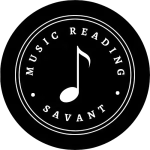| This reading music lesson is a supplement to the Alfred’s Essentials of Music Theory self-study workbook. While no book is perfect for learning how to read music, this is one of the best available. The concise explanations, brief practice exercises, ear-training CD’s, glossary of music terms, and answer key make it an excellent value. Buy this top-rated self-study course for beginners to advanced musicians and follow along with me. |
What are Clef Signs?
Clef signs are the symbols that you see at the very beginning of a music staff.
They help us organize the staff so that music notes can be read with ease.
The purpose is to tell the reader where each note (and letter name) will go.
In other words, a clef sign tells us what lines and spaces of the staff will represent each note.
There are 3 common clef signs:
- Treble Clef
- Bass Clef
- C Clefs
Within the C Clefs, there are 3 different types:
- Soprano Clef
- Tenor Clef
- Alto Clef
Each of these clefs show pitches by designating one line as a letter name.
This is our starting pitch where we can work up or down the staff from there using the music alphabet.
The treble clef and bass clef are used much more frequently than the C clefs, but we will go over each one which briefly to help you get started reading music notes.
So, let’s get started with the treble clef! Travel over to Treble Clef – Reading Music Lesson #8
